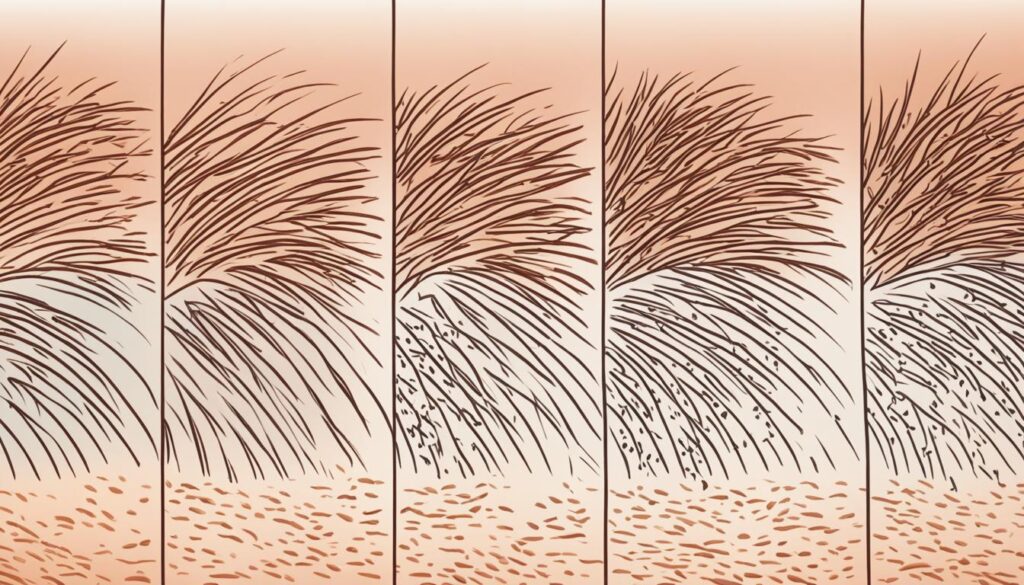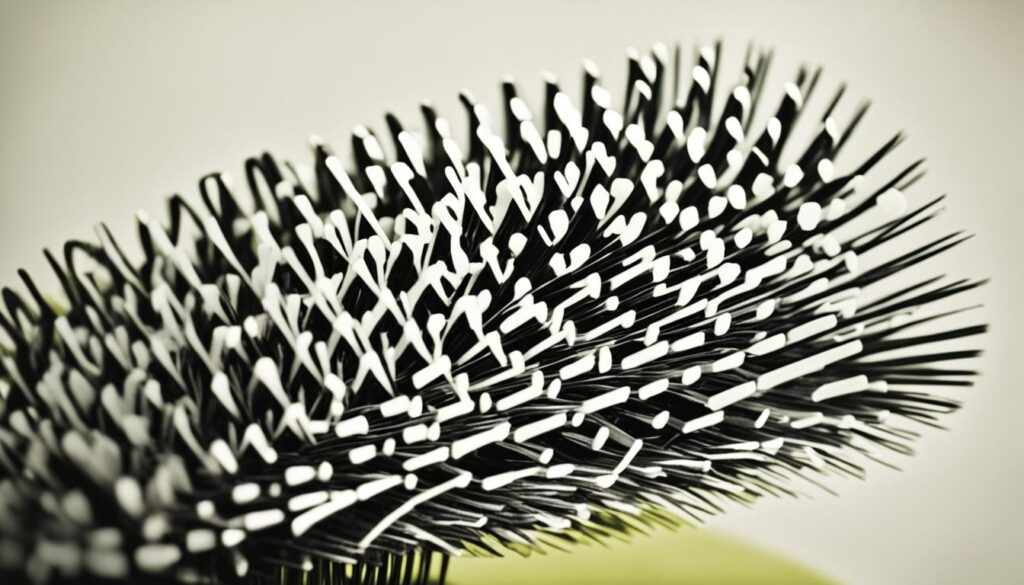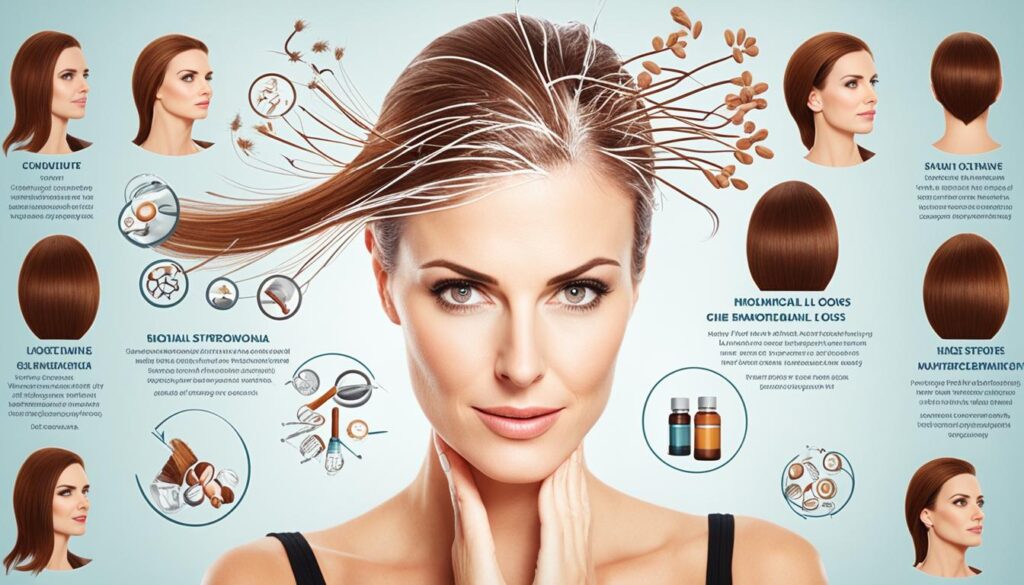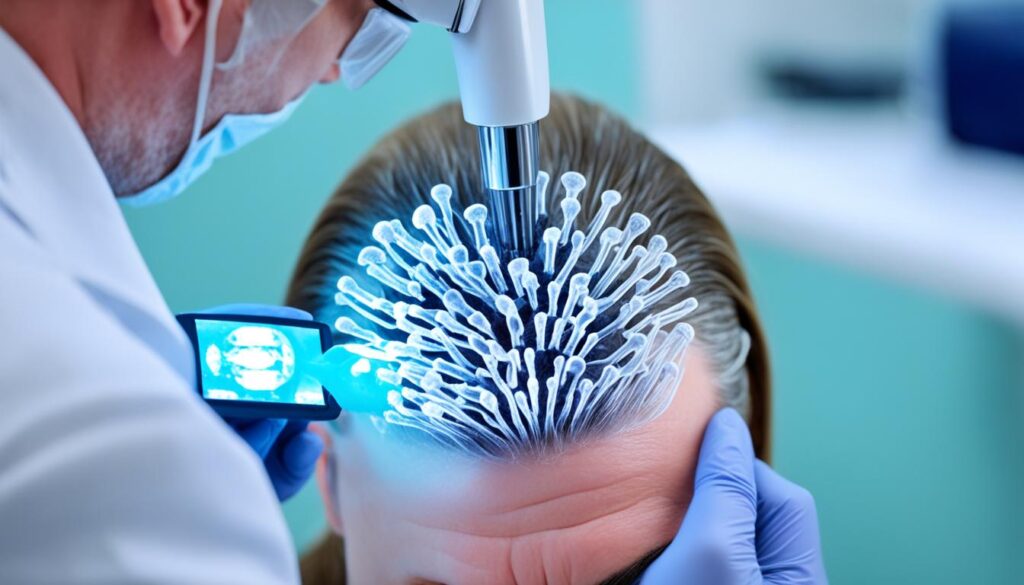Have you ever wondered why some people experience hair loss while others maintain a full head of hair throughout their lives? Is it simply a matter of genetics, or are there other factors at play? In this article, we will delve into the fascinating world of hair loss and explore the various causes and solutions. Prepare to unravel the mysteries behind hair regrowth and prevention!
Key Takeaways:
- Understanding the causes of hair loss is essential for finding effective solutions.
- Various factors, including genetics, medical conditions, and lifestyle choices, can contribute to hair loss.
- Preventive measures and treatments are available to promote hair regrowth and minimize further loss.
- Consulting with healthcare professionals is crucial for accurate diagnosis and personalized recommendations.
- Ongoing research and advancements in hair loss treatment offer promising prospects for the future.
The Importance of Understanding Hair Loss
Understanding the underlying causes of hair loss is essential for individuals who are experiencing it. Hair loss can have a significant impact on a person’s self-esteem and emotional well-being. By understanding the causes and treatments for hair loss, individuals can make informed decisions about their hair care and seek appropriate solutions to minimize the impact of hair loss on their lives.
When individuals understand the reasons behind their hair loss, they can take proactive steps to address the issue. By identifying whether the hair loss is due to genetics, hormonal changes, medical conditions, or other factors, individuals can seek appropriate treatments and adopt preventive measures to minimize further loss.
In addition to the physical impact, hair loss can also have psychological effects on individuals. The alteration in appearance can lead to decreased self-confidence, anxiety, and even depression. Understanding the psychological effects of hair loss can help individuals seek support and coping strategies to navigate the emotional challenges associated with it.
Moreover, understanding hair loss empowers individuals to explore the available treatments and management options. From medication to hair transplant surgeries, there are numerous solutions that can help individuals regain their hair and confidence. By being knowledgeable about their options, individuals can make decisions that align with their preferences and goals.
In summary, the importance of understanding hair loss lies in its ability to empower individuals to take control of their situation. By understanding the causes, impact, and available treatments, individuals can make informed decisions about their hair care and seek appropriate solutions. Whether it’s preventive measures or regrowth treatments, having a comprehensive understanding of hair loss can significantly improve the quality of life for those experiencing it.
The Phenomenon of Hair Loss and Its Extent
Hair loss is a common phenomenon that can occur in both men and women of all ages. It is a condition that affects the scalp or the entire body and can vary in its extent from minor thinning to complete baldness. Understanding the prevalence and extent of hair loss is important for individuals who are seeking treatment or preventive measures.
Hair loss, also known as alopecia, can have a significant impact on an individual’s appearance and self-esteem. It is estimated that approximately 50 million men and 30 million women in the United States alone experience hair loss to some extent.
Extent of Hair Loss: Hair loss can range from mild thinning to more severe forms, such as male-pattern baldness or female-pattern baldness. In some cases, hair loss can be temporary, such as in telogen effluvium, while in others, it can be permanent, such as in androgenetic alopecia.
Prevalence of Hair Loss: The prevalence of hair loss varies depending on factors such as age, sex, and genetics. Male-pattern baldness, for example, affects approximately 50% of men over the age of 50. Female-pattern baldness, on the other hand, becomes more common with age and affects around 40% of women by the age of 50.
Image:

It is important to note that while hair loss is a natural part of the aging process, excessive or premature hair loss may be a cause for concern. If you are experiencing significant hair loss or are concerned about your hair’s health, it is recommended to consult with a healthcare professional or a dermatologist who specializes in hair and scalp conditions. They can provide a thorough evaluation and recommend appropriate treatments or preventive measures based on your individual needs.
Common Patterns of Hair Loss in Men and Women
Hair loss manifests in different patterns and forms for both men and women. Understanding these patterns is crucial for identifying the type of hair loss and determining the appropriate treatments or preventive measures. The three most common patterns of hair loss are male-pattern baldness, female-pattern baldness, and alopecia areata.
Male-Pattern Baldness and Its Impact
Male-pattern baldness, also known as androgenetic alopecia, is the most common type of hair loss in men. It is characterized by a receding hairline and thinning of hair on the crown of the head. This pattern of hair loss is typically caused by a combination of genetic and hormonal factors. Male-pattern baldness can have a significant impact on a man’s self-esteem and confidence.
Female-Pattern Baldness and Thinning Hair
Female-pattern baldness, also called androgenetic alopecia, is the most common type of hair loss in women. Unlike men, women typically experience overall thinning of hair rather than a receding hairline. Female-pattern baldness is also influenced by genetics and hormonal factors. It can have a profound effect on a woman’s self-image and emotional well-being.
Understanding Alopecia Areata
Alopecia areata is a common autoimmune disease that causes patchy hair loss on the scalp, face, or body. It occurs when the immune system mistakenly attacks the hair follicles, leading to hair loss. The exact cause of alopecia areata is unknown, but it is believed to have both genetic and environmental triggers. This condition can be unpredictable, with hair regrowth possible in some cases.
Recognizing the Signs and Symptoms of Hair Loss
Early detection and intervention are crucial in managing hair loss. By recognizing the signs and symptoms, individuals can take appropriate action to address their concerns. Hair loss can manifest in two main forms: gradual thinning and patchy hair loss.
Gradual Thinning vs. Patchy Hair Loss
Gradual thinning is one of the most common signs of hair loss. It typically begins with a widening part or a decrease in hair density. Over time, the hair becomes thinner and may eventually lead to visible scalp exposure. Gradual thinning can occur in both men and women and is often associated with genetic factors and hormonal changes.
On the other hand, patchy hair loss refers to the development of bald spots on the scalp or other parts of the body. This type of hair loss is commonly seen in conditions such as alopecia areata, an autoimmune disease that causes rapid and unpredictable hair loss in patches. Patchy hair loss can be emotionally distressing and may require medical intervention for treatment.

The Psychological Effects of Hair Loss
The psychological effects of hair loss can be significant and should not be overlooked. Hair is often associated with identity, confidence, and self-esteem, making hair loss a deeply personal experience. Individuals experiencing hair loss may feel self-conscious, anxious, or depressed, and their overall quality of life may be affected.
It is important to address the psychological effects of hair loss alongside treating the physical symptoms. Seeking emotional support, engaging in self-care practices, and exploring counseling or therapy can be helpful in managing the psychological impact of hair loss.
| Signs of Hair Loss | Symptoms of Hair Loss |
|---|---|
| Gradual thinning of hair | Decreased hair density |
| Widening part | Patchy bald spots |
| Visible scalp exposure | Rapid hair loss in patches |
| Emotional distress |
Note: The table above provides a summary of the signs and symptoms of hair loss.
Hair Loss: A Deeper Look into Causes
Hair loss can occur due to various factors, and understanding the underlying causes is crucial for effectively addressing this concern. There are three main categories of causes that contribute to hair loss: heredity and genetic factors, medical conditions, and stress and trauma.
Heredity and Genetic Factors
One of the primary causes of hair loss is hereditary factors. Also known as androgenetic alopecia, this type of hair loss is inheritable and affects both men and women. It is commonly referred to as male-pattern baldness or female-pattern baldness. Genetics play a significant role in determining the susceptibility to hair loss and the age at which it begins. The presence of specific genes can make individuals more prone to hair loss.
Medical Conditions Contributing to Hair Loss
Several medical conditions can contribute to hair loss as a side effect or symptom. Some of the common medical conditions associated with hair loss include:
- Thyroid disorders
- Alopecia areata (an autoimmune disorder)
- Scalp infections
- Hormonal imbalances, such as polycystic ovary syndrome (PCOS)
- Nutritional deficiencies, such as iron or vitamin D deficiency
- Chemotherapy or radiation therapy
It is important to consult with a healthcare professional to diagnose and address any underlying medical conditions contributing to hair loss.
The Role of Stress and Trauma
Chronic stress and trauma can also play a role in hair loss. Stress disrupts the normal hair growth cycle and can lead to excessive shedding or thinning of hair. In some cases, the stress-induced hair loss is temporary and reversible, while in others, it may become chronic. Traumatic events, such as major surgeries or accidents, can also trigger hair loss. The exact mechanisms through which stress and trauma affect hair loss are still being researched, but managing stress levels and seeking support can help mitigate the impact.
By understanding the causes of hair loss, individuals can take proactive steps to address the specific factors contributing to their hair loss. This includes seeking appropriate treatments, making necessary lifestyle changes, and adopting hair care practices that promote hair regrowth and prevent further loss.
Analyzing Hair Loss Risk Factors
Certain factors can increase an individual’s risk of experiencing hair loss. By analyzing these risk factors, individuals can be more proactive in preventing hair loss and seeking appropriate treatments.

- Family history of hair loss
- Aging
- Hormonal changes
- Certain medical conditions
- Poor nutrition
Understanding these factors can help individuals take necessary precautions and make informed decisions regarding their hair health. By addressing these risk factors, individuals can potentially prevent or manage hair loss more effectively.
Proactive Measures for Hair Loss Prevention
Taking proactive measures is crucial for individuals who are at risk or experiencing early signs of hair loss. By adopting effective hair care practices, making lifestyle changes, and focusing on nutrition, you can promote hair health and prevent further loss.
Effective Hair Care Practices
Adopting a proper hair care routine can significantly contribute to preventing hair loss. Here are some tips:
- Avoid excessive heat styling tools such as flat irons and curling irons, as they can cause damage and weaken hair follicles.
- Use gentle hair care products that are suitable for your hair type. Avoid harsh chemicals and opt for natural or organic options whenever possible.
- Be gentle when brushing or combing your hair, especially when it is wet, to avoid unnecessary breakage.
- Avoid tight hairstyles that can cause tension and stress on the hair follicles. Opt for looser hairstyles and avoid frequent use of hair accessories.
- Protect your hair from external factors such as pollution, UV rays, and harsh weather conditions. Wear a hat or use a protective hair spray when necessary.
Lifestyle Changes and Nutrition
Your lifestyle and diet play a crucial role in maintaining healthy hair. Here are some lifestyle changes and nutrition tips to consider:
- Manage stress effectively as chronic stress can contribute to hair loss. Incorporate stress-reducing activities into your daily routine, such as meditation, yoga, or regular exercise.
- Get regular exercise to improve blood circulation to the scalp, promoting hair growth.
- Ensure you have a well-balanced diet that includes essential nutrients for hair health, such as vitamins A, C, E, and B, as well as minerals like iron and zinc.
- Incorporate foods rich in omega-3 fatty acids, such as fatty fish, flaxseeds, and walnuts, which can promote scalp health and reduce inflammation.
- Stay hydrated by drinking an adequate amount of water daily, as dehydration can affect hair health.
Diagnosing Hair Loss: Techniques and Assessments
Diagnosing hair loss can be a complex process that requires the expertise of healthcare professionals. If you’re experiencing hair loss, it’s important to know when to consult a healthcare professional and what to expect during a hair loss evaluation.
When to Consult a Healthcare Professional
If you notice significant hair loss or changes in your hair growth pattern, it’s a good idea to consult a healthcare professional. Seek medical advice if you experience:
- Sudden or rapid hair loss
- Signs of inflammation or irritation on the scalp
- Excessive hair shedding during showering or brushing
- Thinning hair or bald patches
A healthcare professional, such as a dermatologist or trichologist, can evaluate your symptoms, medical history, and perform diagnostic tests to determine the underlying cause of your hair loss.
What to Expect During a Hair Loss Evaluation
During a hair loss evaluation, your healthcare professional will conduct a thorough assessment to diagnose the cause of your hair loss. Here are some common techniques and assessments that may be performed:
- Medical history: The healthcare professional will ask about your medical history, family history of hair loss, and any medications or treatments you are currently taking.
- Physical examination: A physical examination of your scalp, hair follicles, and overall hair health will be conducted.
- Pull test: A pull test involves gently tugging on your hair to assess hair shedding.
- Scalp biopsy: In some cases, a small sample of scalp tissue may be taken for further analysis.
- Blood tests: Blood tests may be conducted to check for hormonal imbalances, nutritional deficiencies, or underlying medical conditions that may contribute to hair loss.
Based on the results of these assessments, your healthcare professional will discuss the diagnosis, possible causes of your hair loss, and recommend suitable treatment options or further evaluations if necessary.

Medicinal and Natural Hair Loss Solutions
When it comes to addressing hair loss, individuals have a range of medicinal and natural treatment options to consider. These solutions can help promote hair regrowth, combat thinning hair, and prevent further loss. By understanding the available treatments, individuals can make informed decisions about the best approach for their specific needs and preferences.
Topical Treatments and Hair Regrowth Medication
One popular option for treating hair loss is through the use of topical treatments and hair regrowth medication. These products are typically applied directly to the scalp and work to stimulate hair follicles, promote blood flow, and encourage new hair growth. Two common medications used in topical treatments are minoxidil and finasteride.
**Minoxidil**: Minoxidil is an FDA-approved medication that comes in liquid or foam form and can be purchased over the counter. It is applied twice daily to the scalp and has been shown to promote hair regrowth in both men and women.
**Finasteride**: Finasteride is an oral medication that requires a prescription. It works by inhibiting the production of dihydrotestosterone (DHT), a hormone that contributes to hair loss. Finasteride has been shown to be effective in treating male-pattern baldness.
Natural Remedies and Alternative Therapy
In addition to medicinal treatments, natural remedies and alternative therapies can also be considered for hair loss management. These approaches focus on using natural ingredients and techniques to nourish the scalp, strengthen hair follicles, and improve overall hair health.
**Herbal supplements**: Certain herbal supplements, such as saw palmetto, pumpkin seed oil, and biotin, are believed to have properties that promote hair growth and reduce hair loss. However, it is important to consult with a healthcare professional before starting any supplements to ensure they are safe and beneficial for your specific condition.
**Scalp massage**: Regular scalp massage can help increase blood circulation to the hair follicles, stimulate hair growth, and reduce stress, which can contribute to hair loss. Massaging the scalp with a gentle, circular motion for a few minutes each day may be beneficial.
**Aromatherapy**: Aromatherapy using essential oils, such as lavender, rosemary, and peppermint, may help promote hair growth and improve scalp health. These oils can be diluted and applied to the scalp or added to shampoo or conditioner for regular use.
Medicinal and Natural Hair Loss Solutions
| Treatment Option | Description |
|---|---|
| Topical Treatments | Medications applied directly to the scalp, such as minoxidil and finasteride, to stimulate hair growth. |
| Oral Medications | Prescription drugs, like finasteride, taken orally to inhibit the hormone responsible for hair loss. |
| Herbal Supplements | Natural supplements containing ingredients like saw palmetto and biotin that aim to promote hair growth and reduce hair loss. |
| Scalp Massage | Technique involving gentle massaging of the scalp to increase blood circulation and stimulate hair follicles. |
| Aromatherapy | Use of essential oils, such as lavender and rosemary, to improve scalp health and promote hair growth. |
Advancements in Hair Loss Treatment and Research
Hair loss treatment and research have witnessed significant advancements in recent years, offering hope for individuals struggling with hair loss. These advancements include innovative techniques in hair transplantation, the promising field of hair cloning, and the potential of gene therapy for hair regrowth.
One of the notable advancements in hair loss treatment is in hair transplantation techniques. Traditional hair transplantation involves moving healthy hair follicles from one area of the scalp to the balding areas. However, advanced techniques such as follicular unit extraction (FUE) and robotic hair transplantation have improved the precision and efficiency of the procedure, resulting in more natural-looking results and faster recovery times.

Another groundbreaking area of research is hair cloning, which involves using stem cells to grow new hair follicles in a laboratory. This technique holds promising potential to produce an abundant supply of hair follicles for transplantation, eliminating the need for donor areas on the scalp. Although hair cloning is still in the experimental stage, it shows great promise for future hair loss treatment options.
Additionally, gene therapy has emerged as a potential solution for hair regrowth. Gene therapy aims to modify or add genes to the scalp to stimulate hair growth. By targeting specific genes associated with hair loss, researchers hope to develop targeted treatments that can effectively trigger hair regrowth in individuals experiencing various types of hair loss.
These advancements in hair loss treatment and research offer hope for individuals seeking effective solutions for their hair loss concerns. Staying informed about these advancements can empower individuals to explore the latest treatment options and potentially participate in clinical trials or research studies, playing a significant role in the future of hair loss treatment.
Conclusion
In conclusion, understanding the causes of hair loss is crucial for finding effective solutions and preventive measures. Hair loss can have a significant impact on a person’s self-esteem and emotional well-being, making it important to address the issue proactively. By recognizing the signs and symptoms of hair loss, individuals can take the necessary steps to manage their concerns.
Consulting with healthcare professionals is essential for personalized advice and recommendations based on individual circumstances. They can provide expert guidance on specific treatments and lifestyle changes that can promote hair regrowth and prevent further loss. Whether it is through topical treatments, hair regrowth medications, or natural remedies, there are various options available for individuals seeking effective solutions.
Additionally, staying informed about advancements in hair loss treatment and research is key. Techniques such as hair transplantation, hair cloning, and gene therapy are constantly evolving, offering new possibilities for individuals experiencing hair loss. By staying updated, individuals can explore the latest treatment options and participate in clinical trials or research studies.
In summary, understanding the causes of hair loss, recognizing the signs and symptoms, and exploring available treatments are essential steps for managing hair loss concerns. By taking proactive measures and seeking appropriate advice, individuals can regain confidence and maintain optimal hair health.









